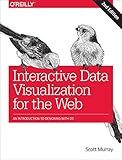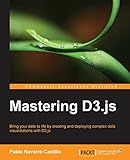Best D3.js Graph Drawing Tools to Buy in December 2025

D3.js in Action, Third Edition



D3.js in Action: Data visualization with JavaScript



Interactive Data Visualization for the Web: An Introduction to Designing with D3



Developing a D3.js Edge



Mastering D3.js - Data Visualization for JavaScript Developers


To draw a dated graph using d3.js, you will first need to create an svg element on your webpage where the graph will be displayed. Next, you'll need to define the dimensions of the svg element, as well as margins for your graph.
Once you have set up the svg element, you can start creating your graph using d3.js. You can use the d3.scaleTime() function to create scales for your x and y axes, and map your data to these scales. You can also use d3.line() to create a line graph, and d3.axis() to create axes for your graph.
To add dates to your graph, you can use javascript's Date object to parse your date values and format them for display on the graph. You can also use d3.timeFormat() to format your date values in a specific way.
Finally, you can use d3.js to draw your graph by appending svg elements such as paths and circles to represent your data points. Make sure to set the appropriate attributes for these elements, such as color, size, and position.
Overall, drawing a dated graph using d3.js involves setting up an svg element, creating scales for your axes, formatting your date values, and using d3.js to draw your graph on the webpage.
How to integrate external data sources for a dated graph in d3.js?
To integrate external data sources for a dated graph in d3.js, you can follow these steps:
- Load the external data source: You can use the d3.js method d3.csv() or d3.json() to load data from an external CSV or JSON file respectively. For example:
d3.csv("data.csv", function(data) { // Process the data here });
- Parse the data: Once the data is loaded, you need to parse it into a format that is suitable for creating the graph. You may need to convert date strings to Date objects or format the data in a way that can be easily used in d3.js.
- Create the graph: Use the parsed data to create the graph using the d3.js methods like d3.scaleTime() for time scales and d3.line() for creating a line chart. Make sure to set the x-axis to the date values from the data.
var x = d3.scaleTime() .domain(d3.extent(data, function(d) { return d.date; })) .range([margin.left, width - margin.right]);
var y = d3.scaleLinear() .domain([0, d3.max(data, function(d) { return d.value; })]) .range([height - margin.bottom, margin.top]);
var line = d3.line() .x(function(d) { return x(d.date); }) .y(function(d) { return y(d.value); });
- Render the graph: Use d3.js to render the graph on the webpage by appending svg elements like axes, lines, labels, etc.
svg.append("path") .datum(data) .attr("class", "line") .attr("d", line);
svg.append("g") .attr("transform", "translate(0," + (height - margin.bottom) + ")") .call(d3.axisBottom(x));
svg.append("g") .attr("transform", "translate(" + margin.left + ",0)") .call(d3.axisLeft(y));
By following these steps, you can integrate external data sources for a dated graph in d3.js and visualize the data effectively.
How to handle real-time data updates in a dated graph using d3.js?
To handle real-time data updates in a dated graph using d3.js, you can follow these steps:
- Set up a data structure to store the real-time data updates. This could be an array or an object that stores the timestamp and value of each data point.
- Create a function to update the graph with the new data points. This function should check for new data points at regular intervals or upon receiving new data, and then update the graph accordingly.
- Use d3.js to update the graph when new data points are added. You can use d3's enter, update, and exit functions to manage the data binding and update the graph with the new data points.
- To handle the dated aspect of the graph, you can use a time scale in d3.js to display dates on the x-axis. This will allow you to easily update the graph with new data points based on their timestamp.
Overall, handling real-time data updates in a dated graph using d3.js involves storing the data updates, updating the graph with new data points, and using d3.js to manage the data binding and display the data on the graph.
What is the best approach for handling zoom and pan functionality in dated graphs with d3.js?
One approach for handling zoom and pan functionality in dated graphs with d3.js is to use d3's built-in zoom behavior. This behavior allows you to easily add zooming and panning functionality to your graph.
To do this, you can first create a zoom object using d3.zoom(), and then attach it to an SVG element that contains your graph. You can then specify the zoom behavior by setting the zoom's event handlers, such as on zoom, on start, on end, and on zoomed.
You can also customize the zoom behavior by setting various properties of the zoom object, such as the extent of the zooming (e.g., limiting zooming to a certain scale range), enabling/disabling specific zoom features (e.g., zooming with the mouse wheel, zooming with touch events), and defining the behavior of the zoom (e.g., translating only along the x-axis, scaling only along the y-axis).
Overall, using d3's zoom behavior is a powerful and flexible way to add zoom and pan functionality to your dated graphs, allowing users to interactively explore and analyze the data.
How to implement tooltips for a dated graph in d3.js?
To implement tooltips for a dated graph in d3.js, you can follow these steps:
- First, create a container element to hold the tooltip:
- Add a mouseover event listener to the elements of the graph that you want to display tooltips for. Inside the event listener, update the tooltip content and position it relative to the mouse cursor:
// Select the elements to add tooltips to const bars = d3.selectAll('.bar');
bars.on('mouseover', function(d) { d3.select('#tooltip') .html(`Date: ${d.date} Value: ${d.value}`) .style('left', (d3.event.pageX + 10) + 'px') .style('top', (d3.event.pageY - 30) + 'px') .style('opacity', 1); });
bars.on('mouseout', function(d) { d3.select('#tooltip').style('opacity', 0); });
- Style the tooltip element:
#tooltip { background-color: white; border: 1px solid black; padding: 5px; font-size: 12px; pointer-events: none; }
With these steps, you should be able to display tooltips for a dated graph in d3.js when the user hovers over the graph elements.
